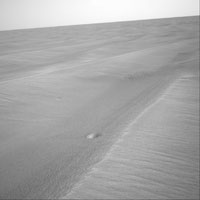

Image Below form NASA: Tiny Craters on Meridiani Planum These two craters, each smaller than a foot in diameter and less than one-half inch deep, were found intact by NASA's Mars rover Opportunity. Image credit: NASA/JPL

X-Prize
two weeks. This must be essentially the same vehicle: propellant can be replaced, but most of the rest of the vehicle must be reused. Even NASA's space shuttle falls short of this performance requirement, since it takes much more than two weeks to ready a given shuttle between flights. This prize foundation was created to encourage the development of private space travel, which is why government-funded projects are not allowed. The X Prize is designed to help create a space industry, and is modeled after many prizes from the early 20th century that helped prod the development of air flight—notably the $25,000 Orteig Prize that spurred Charles Lindbergh to make his solo flight across the Atlantic Ocean. The X-Prize Foundation (based in St. Louis, Missouri) maintains a list of organizations registered
Ulysses (spacecraft)
for the Latin translation of Odysseus) was launched in October 1990 from the Space Shuttle Discovery (mission STS-41) as a joint venture of NASA and the European Space Agency. The spacecraft first flew to Jupiter for a swing-by maneuver which brought it out of the ecliptic plane, in order to investigate the polar regions of the sun. It did explore both the northern and southern solar pole, which gave many unexpected result. Especially the southern magnetic pole was found to be much more dynamical and without any fixed clear magnetic pole. The short version "The sun has no magnetic south pole" is misleading, as the sun is not a magnetic monopole. Ulysses' mission is extended until at least 2004.
However reality was to interject and NASA found themselves with a rapidly plunging budget. Rather than stepping back and looking at their future as a whole given their new financial situation, they attempted to save as many of the individual projects as possible. The mission to Mars was quickly eliminated, but the Space Station and Shuttle continued on. Eventually only one of them could be saved, so it stood to reason that a low-cost Shuttle system would be the better bet, because without it a large station would never be affordable.